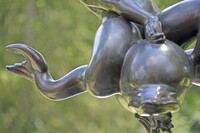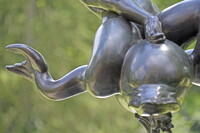| dc.coverage.spatial | Site: Cranbrook Educational Community (Bloomfield Hills, Michigan, United States) | en_US |
| dc.coverage.temporal | 1917-1918 (creation) | en_US |
| dc.creator | Milles, Carl | en_US |
| dc.date | 1917-1918 | en_US |
| dc.date.accessioned | 2016-08-23T18:12:54Z | |
| dc.date.available | 2016-08-23T18:12:54Z | |
| dc.date.issued | 1917-1918 | en_US |
| dc.identifier | 267840 | en_US |
| dc.identifier.other | archrefid: 3253 | en_US |
| dc.identifier.uri | http://hdl.handle.net/1721.3/184154 | |
| dc.description | Detail, body of the dolphin; Milles was Swedish, and had worked as an assistant to Rodin. In 1917 he destroyed most of the work in his Millesgarden studio to embark on a new course. Sunglitter was one of the first sculptures in his new style, and remained a favorite work for him. In 1931, American publisher George Gough Booth brought Milles to Cranbrook Educational Community, in Bloomfield Hills, Michigan, to serve as his sculptor in residence. This is the first (purchased 1929) of 71 sculptures by Milles collected by Booth. Sunglitter is a sculpture of a naiad (a water nymph) or mermaid riding a dolphin. Saarinen placed in carefully on the campus and it is dramatically framed when viewed from the Maija Grotell Courtyard. It exists in multiple casts including one outside the National Museum in Stockholm. Source: Wikipedia; http://en.wikipedia.org/wiki/Main_Page (accessed 7/20/2015) | en_US |
| dc.format.medium | bronze | en_US |
| dc.rights | © Scott Gilchrist, Archivision, Inc. | en_US |
| dc.subject | animal | en_US |
| dc.subject | mythology (Classical) | en_US |
| dc.subject | Dolphins | en_US |
| dc.subject | Twentieth century | en_US |
| dc.title | Sunglitter | en_US |
| dc.title.alternative | Solglitter | en_US |
| dc.type | image | en_US |
| dc.rights.access | Licensed for educational and research use by the MIT community only | en_US |
| dc.identifier.vendorcode | 6A1-MC-SUN-A06 | en_US |
| vra.culturalContext | American | en_US |
| vra.technique | casting (process) | en_US |
| vra.worktype | sculpture (visual work) | en_US |
| dc.contributor.display | Carl Milles (Swedish sculptor, 1875-1955) | en_US |


